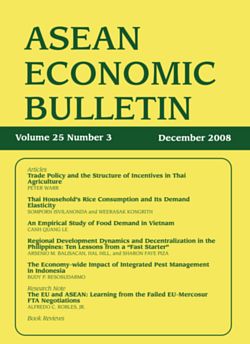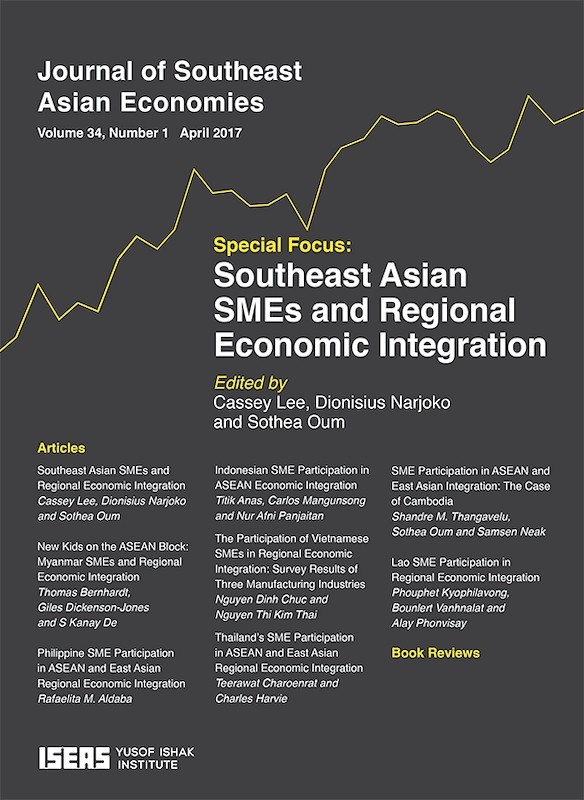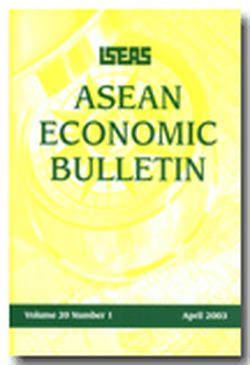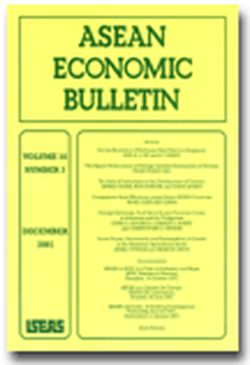ASEAN Economic Bulletin Vol. 24/2 (Aug 2007)

Date of publication:
August 2007
Number of pages:
108
Code:
AE24/2
Contents
-
ASEAN Economic Bulletin Vol. 24/2 (Aug 2007)
-
Preliminary pages
- ARTICLES
-
Asian Economic Integration: ASEAN+3+1 or ASEAN+1s?, by Amita Batra, author see abstractThis paper presents the economic rationale for a regional trade bloc in Asia comprising the ASEAN economies, China, Japan, Korea and India, i.e. the ASEAN+4. The inclusion of India in the trade bloc is justified on the basis of increasingly intense trade relations between India and ASEAN+3 and also the increasing importance that India has come to acquire as a market for the ASEAN+3. Alternative approaches to the alignment of ASEAN and the plus four economies for the formation of the ASEAN+4 trade bloc have been evaluated in terms of their efficiency costs. Efficiency costs are determined by the extent of trade distortion and trade diversion implied by each country's participation in the proposed trade bloc. The findings of this analysis underscore the efficiency of a prior alignment with ASEAN for all the plus four economies.
-
Are the Economies of ASEAN and the EU Complementary?, by Bernadette Andreosso-O'Callaghan, Francoise Nicolas, authors see abstractThe revival of EU-ASEAN economic relations has recently been stirred by the EU-ASEAN Vision Group that was set up in 2005, with the aim of looking into the possibility of a free trade area (FTA) between the two regions. This article analyses the economic feasibility of an EU-ASEAN FTA by measuring the degree of complementarity existing between the economic structures of both regions. The idea is that the greater the complementarity, the higher the scope for trade expansion between the two economies, the lower the costs induced by resource reallocation and the more desirable and successful the FTA. Using a standard trade complementarity index, we find a clear manufacturing-services complementarity between the two regions. At a lower level of aggregation, ASEAN displays a relative comparative advantage in automatic data processing machines (an EU structural weakness). Moreover, for the large majority of manufactured products traded, intra-industry trade (IIT) ratios are relatively low, denoting important trade complementarities between the two regions in general.
-
The Determinants of Inbound Tourism in Laos, by Latsany Phakdisoth, Donghun Kim, authors see abstractThis paper specifies static and dynamic panel demand models for tourism in Laos and estimates tourism demand equations using tourist inflow data for the period 19952004. The models allow us to estimate the short- and long-run effects of tourism determinants. We find that communication and transportation infrastructure, destination risk, bilateral trade, and distance between Laos and countries of origin are, in the long run, among the main determinants of tourism to Laos. In particular, we find that tourism to Laos is income and price inelastic. This suggests that tourism to Laos is not a luxury good. The results of dynamic models indicate that relative price and infrastructure are more important determinants than income in the short-run adjustment of tourist inflow.
-
The Importance of the Food Industry to the Thai Economy: An Input-Output Perspective, by Sunetra Lekuthai, author see abstractThe food industry has received discontinuous support from the government over the past decades. The contribution of the food industry in terms of increasing value added of agricultural products is often shed light, while studies on other aspects have been limited. This paper provides a sector comparison on the benefits of the food industry to the whole economy, using Thailand Input-Output tables of years 1980, 1990, and 2000. The empirical analyses concluded that among various leading industries, the food industry provided the strongest contributions to the Thai economy in terms of production inducement, employment generation, value added inducement and net foreign exchange earning although its export value was not the highest.
- RESEARCH NOTES
-
Building Blocks or Stumbling Blocks? The GMS and AFTA in Asia, by Jayant Menon, author
-
The National Element in Regional Trade Agreements: The Role of Southeast Asian Countries in ASEAN-EU Trade, by Lena Lindberg, Claes Goran Alvstam, authors
- BOOK REVIEWS
-
BOOK REVIEW: Transforming Microfinance Institutions: Providing Full Financial Services to the Poor, by Joanna Ledgerwood and Victoria White., by Robert L Curry, Jr., author
-
BOOK REVIEW: Think ASEAN! Rethinking Marketing toward ASEAN Community 2015, by Philip Kotler, Hermawan Kartajaya, and Hooi Den Huan., by Agung Wicaksono, author
-
BOOK REVIEW: Financial Fragility and Instability in Indonesia, by Yasuyuki Matsumoto., by Karyn Wang, author
-
BOOK REVIEW: Chinas Domestic Grain and Marketing Reform and Integration, edited by Chunlai Chen and Christopher Findlay., by Jan P Voon, author
-
BOOK REVIEW: Third ASEAN State of the Environment Report 2006: Towards an Environmentally Sustainable ASEAN Community, by ASEAN Secretariat; and Asian Aspirations for Climate Regime Beyond 2012: Energy Security and Development Needs, Clean Development Mechanism, Technology Development and Transfer, Adaptation to Climate Change, edited by Ancha Srinivisan., by Lee Poh Onn, author





